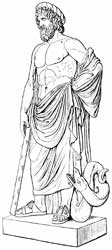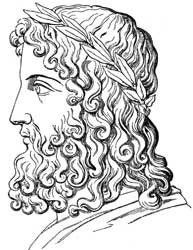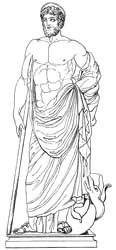Asclepius
The god of the medical art. In the Homeric poems Asclepius does not appear to be considered as a divinity, but merely as a human being, which is indicated by the adjective ἀμύμων (amymōn), which is never given to a god. No allusion is made to his descent, and he is merely mentioned as the ἰητὴρ ἀμύμων (iētēr amymon), and the father of Machaon and Podalirius.1
From the fact that Homer2 calls all those who practice the healing art descendants of Paeëon, and that Podalirius and Machaon are called the sons of Asclepius, it has been inferred, that Asclepius and Paeëon are the same being, and consequently a divinity. But wherever Homer mentions the healing god, it is always Paeëon, and never Asclepius; and as in the poet's opinion all physicians were descended from Paeëon, he probably considered Asclepius in the same light. This supposition is corroborated by the fact, that in later times Paeëon was identified with Apollo, and that Asclepius is universally described as a descendant of Apollo.
The two sons of Asclepius in the Iliad were the physicians in the Greek army, and are described as ruling over Tricca, Ithome, and Oechalia.3 According to Eustathius,4Lapithes was a son of Apollo and Stilbe, and Asclepius was a descendant of Lapithes. This tradition seems to be based on the same groundwork as the more common one, that Asclepius was a son of Apollo and Coronis, the daughter of Phlegyas, who is a descendant of Lapithes.5

The common story then goes on as follows. When Coronis was with child by Apollo, she became enamored with Ischys an Arcadian, and Apollo informed of this by a raven, which he had set to watch her, or, according to Pindar, by his own prophetic powers, sent his sister Artemis to kill Coronis. Artemis accordingly destroyed Coronis in her own house at Lacereia in Thessaly, on the shore of lake Baebia.6 According to Ovid7 and Hyginus,8 it was Apollo himself who killed Coronis and Ischys. When the body of Coronis was to be burnt, Apollo, or, according to others,9Hermes, saved the child (Asclepius) from the flames, and carried it to Chiron, who instructed the boy in the art of healing and in hunting.10
According to other traditions Asclepius was born at Tricca in Thessaly,11 and others again related that Coronis gave birth to him during an expedition of her father Phlegyas into the Peloponnese, in the territory of Epidaurus, and that she exposed him on Mount Tittheion, which was before called Myrtion. Here he was fed by a goat and watched by a dog, until at last he was found by Aresthanas, a shepherd, who saw the boy surrounded by a luster like that of lightning.12 From this dazzling splendor, or from his having been rescued from the flames, he was called by the Dorians αἰγλαήρ (aiglaēr).
The truth of the tradition that Asclepius was born in the territory of Epidaurus, and was not the son of Arsinoe, daughter of Leucippus and born in Messenia, was attested by an oracle which was consulted to decide the question.13 After Asclepius had grown up, reports spread over all countries, that he not only cured all the sick, but called the dead to life again. About the manner in which he acquired this latter power, there were two traditions in ancient times. According to the one,14 he had received from Athena the blood which had flowed from the veins of Gorgo, and the blood which had flowed from the veins of the right side of her body possessed the power of restoring the dead to life.
According to the other tradition, Asclepius on one occasion was shut up in the house of Glaucus, whom he was to cure, and while he was standing absorbed in thought, there came a serpent which twined round the staff, and which he killed. Another serpent then came carrying in its mouth a herb with which it recalled to life the one that had been killed, and Asclepius henceforth made use of the same herb with the same effect upon men.15
Several persons, whom Asclepius was believed to have restored to life, are mentioned by the Scholiast on Pindar16 and by Apollodorus.17 When he was exercising this art upon Glaucus, Zeus killed Asclepius with a flash of lightning, as he feared lest men might gradually contrive to escape death altogether,18 or, according to others, because Hades had complained of Asclepius diminishing the number of the dead too much.19 But, on the request of Apollo, Zeus placed Asclepius among the stars.20
Asclepius is also said to have taken part in the expedition of the Argonauts and in the Calydonian Hunt. He was married to Epione, and besides the two sons spoken of by Homer, we also find mention of the following children of his: Janiscus, Alexenor, Aratus, Hygieia, Aegle, Iaso, and Panacea,21 most of whom are only personifications of the powers ascribed to their father.

These are the legends about one of the most interesting and important divinities of antiquity. Various hypotheses have been brought forward to explain the origin of his worship in Greece; and, while some consider Asclepius to have been originally a real personage, whom tradition had connected with various marvelous stories, others have explained all the legends about him as mere personifications of certain ideas.
The serpent, the perpetual symbol of Asclepius, has given rise to the opinion, that the worship was derived from Egypt, and that Asclepius was identical with the serpent Cnuph worshiped in Egypt, or with the Phoenician Ešmun.22 But it does not seem necessary to have recourse to foreign countries in order to explain the worship of this god. His story is undoubtedly a combination of real events with the results of thoughts or ideas, which, as in so many instances in Greek mythology, are, like the former, considered as facts. The kernel, out of which the whole myth has grown, is perhaps the account we read in Homer; but gradually the sphere in which Asclepius acted was so extended, that he became the representative or the personification of the healing powers of nature, which are naturally enough described as the son (the effects) of Helios, — Apollo, or the Sun.
Asclepius was worshiped all over Greece, and many towns, as we have seen, claimed the honor of his birth. His temples were usually built in healthy places, on hills outside the town, and near wells which were believed to have healing powers. These temples were not only places of worship, but were frequented by great numbers of sick persons, and may therefore be compared to modern hospitals.23 The principal seat of his worship in Greece was Epidaurus, where he had a temple surrounded with an extensive grove, within which no one was allowed to die, and no woman to give birth to a child. His sanctuary contained a magnificent statue of ivory and gold, the work of Thrasymedes, in which he was represented as a handsome and manly figure, resembling that of Zeus.24 He was seated on a throne, holding in one hand a staff, and with the other resting upon the head of a dragon (serpent), and by his side lay a dog.25
Serpents were everywhere connected with the worship of Asclepius, probably because they were a symbol of prudence and renovation, and were believed to have the power of discovering herbs of wondrous powers, as is indicated in the story about Asclepius and the serpents in the house of Glaucus. Serpents were further believed to be guardians of wells with salutary powers. For these reasons a peculiar kind of tame serpents, in which Epidaurus abounded, were not only kept in his temple,26 but the god himself frequently appeared in the form of a serpent.27 Besides the temple of Epidaurus, whence the worship of the god was transplanted to various other parts of the ancient world, we may mention those of Tricca,28 Celaenae,29 between Dyme and Patrae,30 near Cyllene,31 in the island of Cos,32 at Gerenia,33 near Caus in Arcadia,34 at Sicyon,35 at Athens,36 near Patrae,37 at Titane in the territory of Sicyon,38 at Thelpusa,39 in Messene,40 at Phlius,41 Argos,42 Aegium,43 Pellene,44 Asopus,45 Pergamum,46 Lebene in Crete, Smyrna, Balagrae,47 Ambracia,48 at Rome and other places.
At Rome the worship of Asclepius was introduced from Epidaurus at the command of the Delphic oracle or of the Sibylline books, in 293 BCE, for the purpose of averting a pestilence. Respecting the miraculous manner in which this was effected see Valerius Maximus,49 and Ovid.50
The sick, who visited the temples of Asclepius, had usually to spend one or more nights in his sanctuary (καθεύδειν, katheudein),51 during which they observed certain rules prescribed by the priests. The god then usually revealed the remedies for the disease in a dream.52 It was in allusion to this incubatio that many temples of Asclepius contained statues representing Sleep and Dream.53 Those whom the god cured of their disease offered a sacrifice to him, generally a cock54 or a goat,55 and hung up in his temple a tablet recording the name of the sick, the disease, and the manner in which the cure had been effected. The temples of Epidaurus, Tricca, and Cos, were full of such votive tablets, and several of them are still extant.56

The various surnames given to the god partly describe him as the healing or saving god, and are partly derived from the places in which he was worshiped. Some of his statues are described by Pausanias.57 Besides the attributes mentioned in the description of his statue at Epidaurus, he is sometimes represented holding in one hand a phial, and in the other a stalf; sometimes also a boy is represented standing by his side, who is the genius of recovery, and is called Telesphorus, Euamerion, or Acesius.58 We still possess a considerable number of marble statues and busts of Asclepius, as well as many representations on coins and gems.59
There were in antiquity two works which went under the name of Asclepius, which, however, were no more genuine than the works ascribed to Orpheus.6
The descendants of Asclepius were called by the patronymic name Asclepiadae (Ἀσκληπιάδαι). Those writers, who consider Asclepius as a real personage, must regard the Asclepiadae as his real descendants, to whom he transmitted his medical knowledge, and whose principal seats were Cos and Cnidus.61 But the Asclepiadae were also regarded as an order or caste of priests, and for a long period the practice of medicine was intimately connected with religion. The knowledge of medicine was regarded as a sacred secret, which was transmitted from father to son in the families of the Asclepiadae, and we still possess the oath which every one was obliged to take when he was put in possession of the medical secrets.62
❧
Iconography
Asclepius is portrayed as a kind, bearded man; the staff and the snake are his attributes. He is mainly depicted in sculptures, among which works by Alcamenes and Scopas. Vague copies based on Alcamenes can be found in Berlin and Naples. They portray the god standing, a mantle draped across the left shoulder, and the right arm and shoulder bared. He leans on a staff which is encircled by a snake. The lavish hairstyle and full beard is reminiscent of Zeus.
He is also depicted on numerous votive reliefs and coins. The statue that once stood in the temple at Epidaurus, made by Thrasymedes (fourth century BC) from gold and ivory, is unfortunately lost.
In the Middle Ages illustrations of Asclepius appear in medical books, and in the Renaissance he appears as apothecary in manuscripts.
References
Notes
- Iliad ii, 731; iv, 194; xi, 518.
- Odyssey iv, 232.
- Iliad ii, 729.
- On Homer, 330.
- Pseudo-Apollodorus. The Library iii, 10.3; Pindar. Pythian Odes iii, 14, with the Scholiast.
- Comp. Homeric Hymns, 27.3.
- Metamorphoses ii, 605 ff.
- Poetical Astronomy ii, 40.
- Pausanias. Description of Greece ii, 26.5.
- Pindar. Pythian Odes iii, 1 ff.; Pseudo-Apollodorus. The Library iii, 10.3; Pausanias, l.c.
- Strabo. Geography xiv, 647.
- See a different account in Description of Greece viii, 25.6.
- Pausanias. Description of Greece ii, 26.6; iv, 3.2; Cicero. On the Nature of the Gods iii, 22, where three different Asclepiuses are made out of the different local traditions about him.
- Pseudo-Apollodorus, l.c.
- Hyginus. Poetical Astronomy ii, 14.
- Pindar. Pythian Odes iii, 96.
- l.c.
- Pseudo-Apollodorus. The Library iii, 10.4.
- Diodorus Siculus, iv, 71; comp. Scholiast on Pindar's Pythian Odes iii, 102.
- Hyginus. Poetical Astronomy ii, 14.
- Scholiast on Pindar's Pythian Odes iii, 14; Pausanias. Description of Greece ii, 10.3; i, 34.2.
- Eusebius. Praeparatio Evangelica i, 10; comp. Description of Greece vii, 23.6.
- Plutarch. Quaestiones Romanae, 286, D.
- Pausanias. Description of Greece ii, 26, 27.
- ibid. ii, 27.2.
- ibid. ii, 28.1.
- ibid. iii, 23.4; Valerius Maximus, i, 8.2; Livy. Epitome, 11; compare the account of Alexander Pseudomantis in Lucian.
- Strabo. Geography ix, 437.
- ibid. iii, 603.
- ibid. viii, 386.
- ibid. viii, 337.
- ibid. xiii, 657; Pausanias. Description of Greece iii, 23.4.
- ibid. viii, 360.
- Stephanus of Byzantium, s.v.
- Pausanias. Description of Greece ii, 10.2.
- ibid. i, 21.7.
- ibid. vii, 21.6.
- ibid. vii, 23.6.
- ibid. viii, 25.3.
- ibid. iv, 31.8.
- ibid. ii, 13.3.
- ibid. ii, 23.4.
- ibid. ii, 23.5.
- ibid. vii, 27.5.
- ibid. iii, 22.7.
- ibid. iii, 26.7.
- ibid. ii, 26.7.
- Livy. History of Rome xxxviii, 5.
- i, 8.2.
- Ovid. Metamorphoses xv, 620 ff.; comp. Niebuhr. History of Rome iii, 408 ff.; Livy. History of Rome x, 47; xxix, 11; Suetonius. Life of Claudius, 25.
- Pausanias. Description of Greece ii, 27.2.
- Aristophanes. Plutus, 662 ff.; Cicero. De Divinatione ii, 59; Philostratus. Vita Apollonii i, 7; Iamblicus. De Mysteriis Aegyptiorum iii, 2.
- Pausanias. Description of Greece ii, 10.2.
- Plato. Phaedo. 118.
- Pausanias. Description of Greece x, 32.8; Servius on Virgil's Georgics ii, 380.
- ibid. ii, 27.3; Strabo. Geography viii, 374; comp. Dictionary of Antiquities, 673.
- ibid. x, 3; x, 32.8.
- ibid. ii, 11.7.
- Böttiger. Amalthea i, 282; ii, 361; Hirt. Bilderbuch für Mythologie i, 84; K.O. Müller. Handbuch der Archaeologie der Kunst, 597 ff., 710.
- Fabricius. Bibliotheca Graeca i, 55 ff.
- Plato. Republic iii, 405 ff.
- Galen. Anatomy ii, 128.; Aristides. Orationes i, 80. Comp. Sprengel, K. (1820) Geschichte der Medicin. Vol. 1.
Source
- Smith, William. (1870). Dictionary of Greek and Roman Biography and Mythology. London: Taylor, Walton, and Maberly.
This article incorporates text from Dictionary of Greek and Roman Biography and Mythology (1870) by William Smith, which is in the public domain.